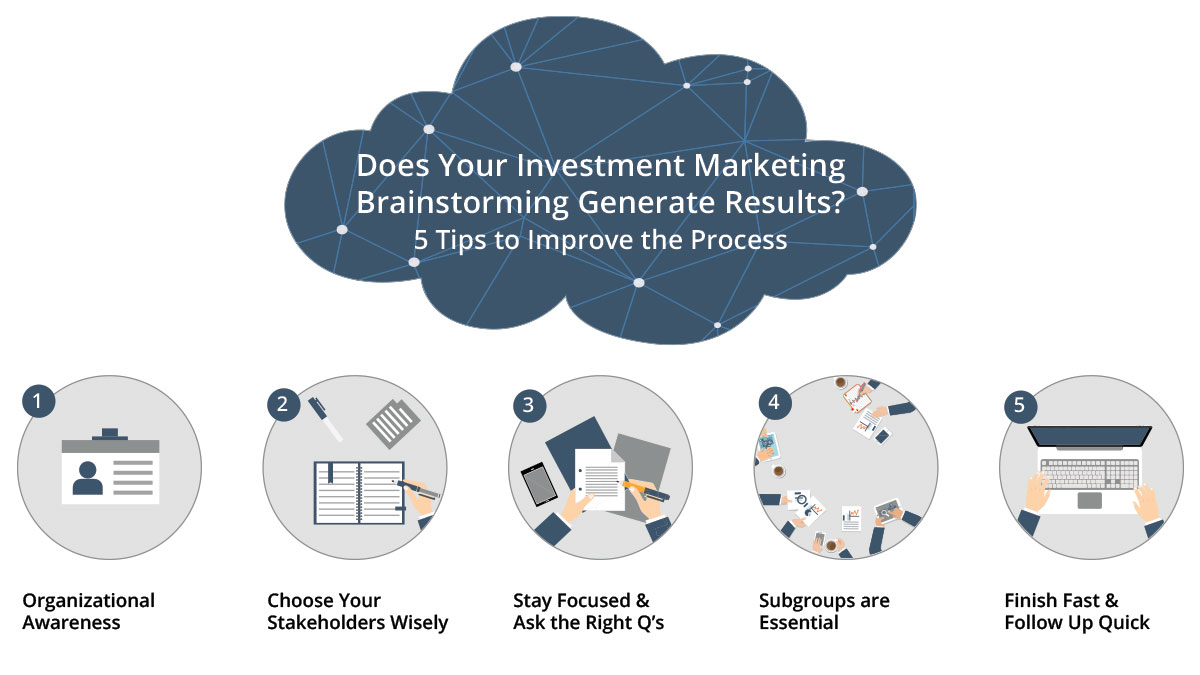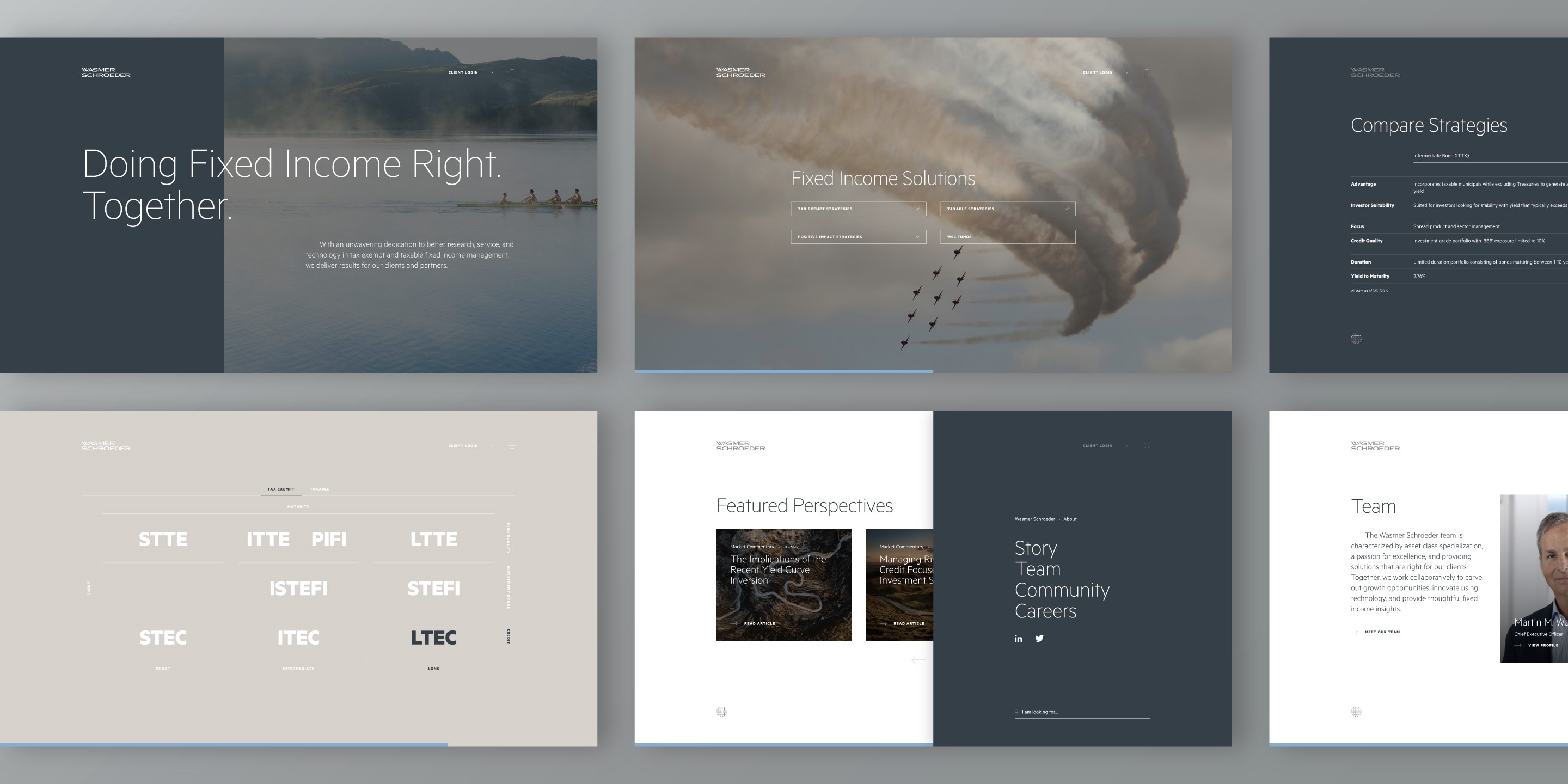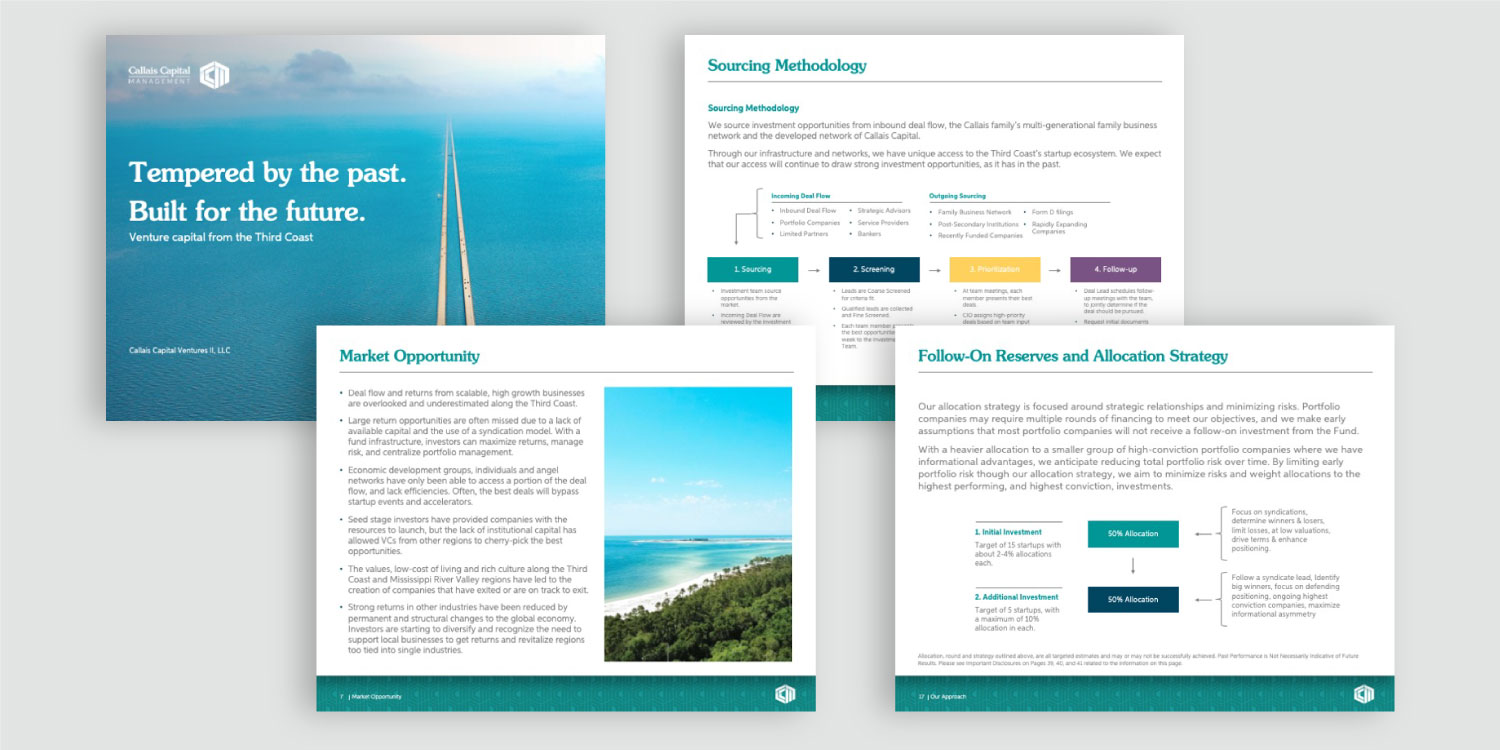Does Your Investment Marketing Brainstorming Generate Results? 5 Tips to Improve the Process.

Internal collaboration and productive idea generation is critical to developing effective marketing campaigns—both inside and outside the world of the financial and investment industries. Successful companies run good ideas, so having inefficient, unfocused marketing brainstorming is a time waster at best, and a message-muddling, exercise in futility at worst.
Though brainstorming can start out with a grand vision and good intentions, structure and organization can slowly begin to fall apart, with the moderator eventually losing direction, giving up and parroting buzzwords like “think outside the box” as they toil through the process.
For all those who have experienced the disappointment of failed marketing brainstorming sessions, we feel your pain, but it doesn’t have to be this way!
The differentiator: direction and perspective
While there is no secret psychological hack to utilize when it comes to an effective investment marketing brainstorm, the differentiator we see between a strong session and a weak one is organization. When properly organized, brainstorming allows us and our clients to take control of two vital characteristics of a healthy session: direction and perspective. Having a definitive direction and structure will keep the session moving, whereas implementing intelligent changes and framing the session with perspective will be what brings new and fresh ideas to the forefront.
So, let’s go over the most critical organizational and perspective-driven aspects of the brainstorming process to ensure that your next marketing and branding meeting exceeds idea generation expectations.
1. Organizational Awareness
In order to avoid one of the more frustrating results of a brainstorm session, namely coming up with a great idea that has no chance of seeing the light of day, you have to be aware of your business needs. An aha moment must be tempered by the reality of the organization itself. Note any major brand, platform or communication restrictions before engaging in brainstorming, and place everyone on a realistic path to productive, relevant and achievable idea generation.

2. Choose Your Stakeholders Wisely
The act of finding innovative marketing solutions through critical thinking is not just reserved for strategists, managers and the C-suite. Some of the most useful programs, initiatives and brand messaging come from those who have unique insights into the issues you’re investigating and the questions you are asking. Need a way to incentivize teller cross-selling at a bank? It would make sense to have a teller in the group to have a tactical understanding of client interaction, as opposed to leaving messaging and techniques up to those higher on the organizational chart. When clients engage us in a creative strategy process, we look to encompass a range of stakeholders who each have a unique perspective on the firm and the specific challenges we are solving.
3. Stay Focused & Ask the Right Questions
This should go without saying but is something that is often missed. Leave the discussion-based brainstorming for less structured moments. Failing to maintain structure or ask the proper line of questions can lead to quantity over quality…the second least-satisfying brainstorming conclusion behind no ideas at all.
While every organization and marketing department will have different questions, they should all have two specific characteristics:
A. Force participants to change perspective. If you are an asset management firm, approach problems and consider solutions from a financial advisor’s point of view. What can you pull from investment product trends to fine-tune your messaging strategy or improve the client experience? While some examples might not be 100% relevant, thinking outside your own realm of expertise can get you out of the groupthink trap and provide a gateway to creating an innovative asset management marketing solution.
B. Limit the conceptual space your team can explore. This should not be so restrictive as to force particular outcomes or answers. For example, “What’s the largest avoidable roadblock related to client experience?” should be changed to “What is a daily process, that if eliminated, would improve the client experience?” It is more focused, and will lead to more focused, actionable answers.

4. Subgroups Are Essential
If you’re brainstorming session is attended by more than 5-10 people, subgroups are critical to running better organized and deliberate meetings. The social norm for large groups is for the majority to stay silent, whereas subgroups of five or less actually incentivize discussion from all participants. Dividing up different personalities and positions is also an option. Outspoken individuals, managers and subject matter experts are all potential disruptors and should be divvied up accordingly. After clarifying expectations to the larger group, separate them into teams and provide each with a focused question to spend time exclusively on. Once the teams are working together on a narrowly-defined question, better thinking soon emerges as the subgroups find ways to improve shallow ideas while maintaining focus on the assigned questions.
5. Finish fast & follow up quick
Now that you have attacked the problem by utilizing different perspectives and tactical awareness through focused questioning in discussion-incentivizing subgroups, you should have generated dozens of ideas, so don’t drag it out. No need for the group to get together and choose the best ideas at the end of the session, have each group submit their best ideas and share them, but don’t pick a winner. Rather, use that time to showcase and celebrate, which can help motivate and inspire the team, ultimately ending the session on a high note, with a sense of productivity permeating throughout the group.
Lastly, decisions about how to follow-up should be made with haste. As momentum fades and time passes, the opportunity for real action from a brainstorming session will decline as well, so having a defined plan of action is key. For example, know what senior leaders are looking for and analyze what ideas are actionable, and then put the ideas into buckets:
A. Immediate implementation planning
B. Assigning a group to research an idea further
C. Rejection
Keeping the team informed on the decision-making process, even the rejections, is highly recommended. While it may seem counterintuitive, informing even on rejections can have a positive effect on a group waiting (sometimes anxiously) for feedback and the simple acknowledgement of them “being heard.”
If all goes according to plan, these marketing strategies and tactics should not only provide great idea generation, the process itself will lead to employees and stakeholders who feel their voices were heard, along with being excited to participate in the future.

Brainstorming and creative ideation is just the first part to a comprehensive financial industry marketing exercise or plan. If you’d like to learn more about how you can begin effectively brainstorming or how to begin executing on all your great new ideas, we are here to help. We’ve helped investment management and financial services firms for the past two decades to create innovative and forward-thinking strategies to solve and implement solutions for some of their biggest marketing and branding problems.
Published:
Tags: investment industry marketing, financial services industry marketing, los angeles investment marketing, tips to improve brainstorming, Financial services brainstorming, 2019 award winning financial marketing, 2019 award winning agency, financial brand marketing, award winning advertising agency, award winning financial service marketing, branding agency with investment experience, branding for investment industry, investment brand strategy, investment marketing and branding, MBC Strategic, MBC Strategic investment marketing